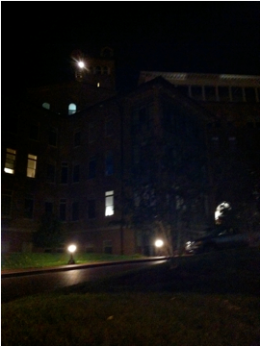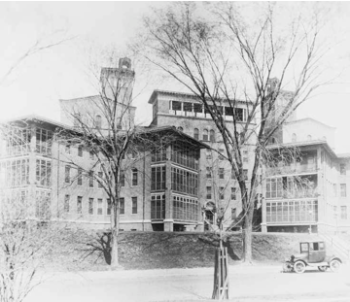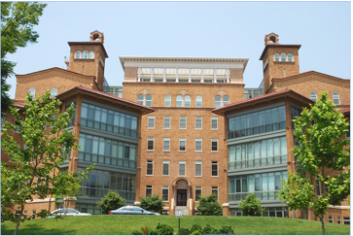When I think of where I live, I think first of the cold. I’ll often walk my dog down 25th Street late at night, when you can walk around in the heart of Washington, DC and not see a single trace of other people except for a light on in one of the dozen or so apartment buildings across the street. I’ll dig my left hand deep down in my pocket, and clutch at the leash the small dog pulls, anxious to get out of the blustery December air. After I walk past the darkened windows of Trader Joe’s, I’ll turn left and see the dark, looming, shapeless building. Skirted by small lights illumining the sidewalk that leads to the front door, the nine-story building fades into the black sky, its slanted roof crowned by a single beacon of light.
The building that was once the Columbia Hospital for Women has occupied the site that is now located at the corner of 24th Street and L Street since 1870. In response to the influx of women entering the city in search of missing relatives, the Secretary of War E. N. Stanton designated funds to establish the fifty-bed hospital, specifying that twenty beds be held for widows of Civil War soldiers. Health care facilities in the metropolitan city were laden with injured soldiers, and the women entering the city often faced adversity in pursuit of care. The Columbia Hospital for Women and Lying-in Asylum originally opened in the Hill Mansion at Thomas Circle, but quickly relocated and expanded in 1914 to its current location. In 1953, President Dwight D. Eisenhower signed the bill over to its board of directors, and it became a private, non-profit hospital. Breaking ground in obstetric and gynecology techniques, the Columbia Hospital for Women was the birth site for more than 250,000 babies since its founding in 1866.1
The Columbia Residences, a luxury 225-unit, $140 million development of the historic Columbia Hospital for Women, an Italianate building dating from the late 19th century, has several units for sale!2 With the recent addition of two wings on the west and east sides, the building sits on the corner of 24th and L Street, smack dab between bustling downtown and trendy-chic Georgetown – what more could you ask for? How about access to the building’s private rooftop swimming pool, full gym, covered garage, and round-the-clock security service? Still not sold? You’ll have stunning views of the National Cathedral, Georgetown University, and the Potomac River to the East, and K Street, the White House, and the Washington Mall to the West! Steps away from the Foggy Bottom Metro Station, the Columbia Residences is the quintessential location for everything Washington – call to make your appointment to tour TODAY!
The cold, white hallway to the gym on the west side of the apartment building feels like a hospital. Halfheartedly decorated with nondescript floral paintings, identical to the hallway upstairs, I rarely pass anyone else as I walk through the least-populated floor of the building. Even at the heart of the Nation’s Capital, the only sound I hear are my keys jingling as they hang off of one finger, and the soft, muffled sound of my feet hitting the drab, olive green carpet. I walk down the hallway further, down a handicapped ramp, and wave the censor on my keychain. A piercing beep indicates my permission to enter the gym. The stark white, sterile walls and overhead florescent lights are almost blinding. A large fan stands on the far side of the room, plugged in, and turned on full speed. The elliptical machines, treadmills, and weights are lined up orderly against the walls, and I feel a chill up my spine when I remember the history my father shared with me about the room: I am standing in the Columbia Hospital for Women’s morgue.
After my parents agreed to separate in 2007, my father moved from our family home into a two-bedroom floor unit in the Columbia Residences. Having worked for the company that developed the old hospital, he knew the history of each room before he decided where he wanted to live, and chose the floor unit despite its close proximity to the former morgue. The building’s history is marked by deaths and births, by ends and beginnings. It remains to this day a place for lost spouses, seeking refuge, and looking for answers. The place that represents the end of one chapter of my father’s life is not represented by the new life of the building, but rather the cold, eerie history seeps through the walls and hangs in the air, undeniable and unavoidable.





I am really impressed by your personal narrative leading up to your entry into the gym and former morgue. You highlight the mood and feeling of your walk through D.C. towards the Columbia residences and build the suspense of your narrative beautifully, only to expose at the end that this place of transience and mundane daily tasks used to have a much heavier and darker purpose. Should you choose to expand on this for your final paper, I would suggest that you make your transitions between the paragraphs smoother. This way, the essay would seem more deliberate in terms of where you placed which paragraph.
I also really enjoy the advertisement blurb you set up and would like to see you build on that. I could see this essay having a similarity to “W or The Memory of Childhood”, where there is a very personal narrative woven throughout a satirical, dry voice depicting a place and becoming a metaphor for something else entirely.
In terms of the photographs, I enjoy the range of emotions and moods that each of them employ. You show the power of photography to highlight a place’s different characters at different times.
I love writing style of your post. Your words captured the essence of Washington D.C. well, and you painted a descriptive picture of how it can really feel to live somewhere that is so highly regarded by everyone else, but to you it is simply where you live. I can also relate to the eerie feeling of living in a place that once housed the sick and the dead. There’s an inescapable discomfort in actually seeing the rooms, as with your photo of the gym, and realizing that the modern world has attempted to pleasantly cover the realities of history.
Hhmorgan makes a nice connection between the hospital’s history, and her family’s history. Many of the descriptions are very good, but with the importance of the specific rooms in portraying the relationship between past and present, more detailed descriptions of the rooms, especially the morgue/gym would add another element to the piece.
I really enjoyed the narrative leading up to entering the gym, because the suspense had a very dynamic effect on your realization that the gym itself once was a morgue. I wonder if you were to expand on this by bringing in Pamuk. It’d be really interesting if you could find out from your father about how other residents feel about the building. Perhaps, there is a certain type of huzun shared by residents of this building that could add an interesting dimension to your post!